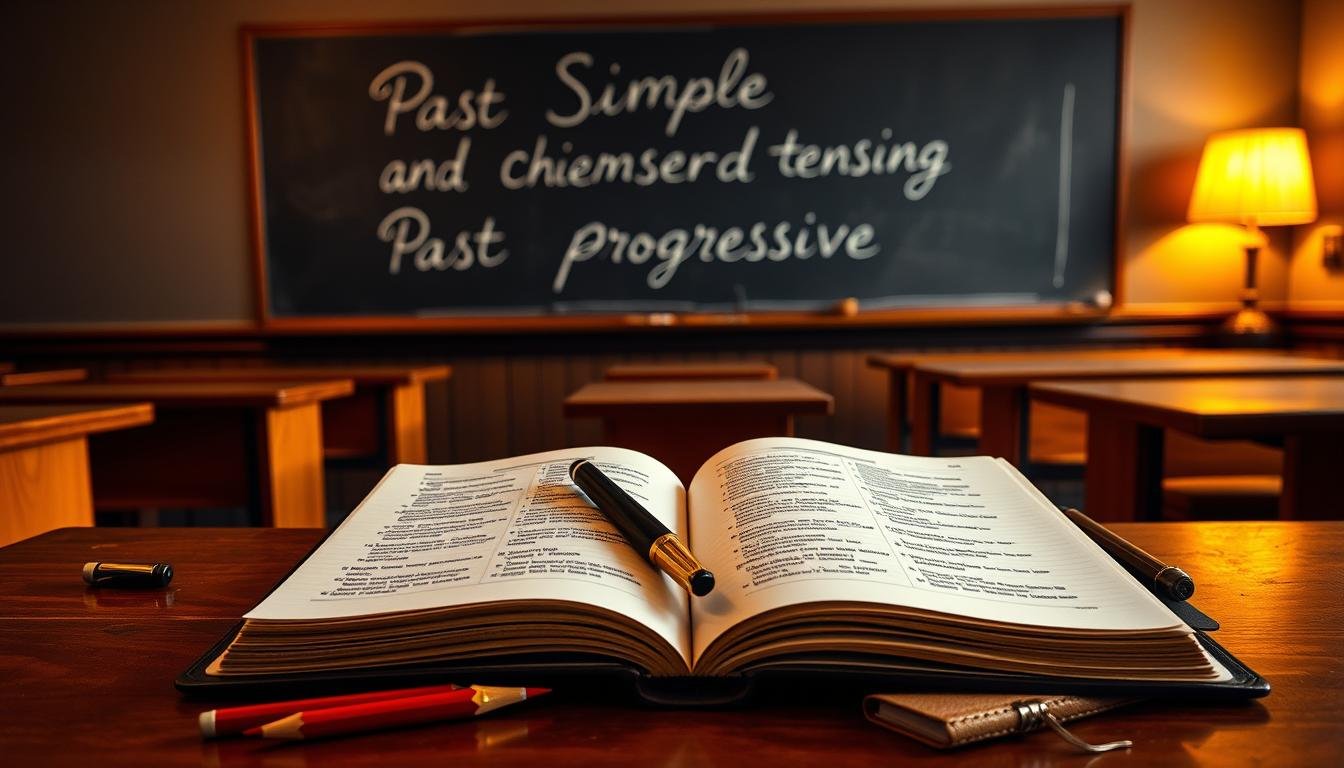Now Reading: Past Progressive and Past Simple: Exploring the Differences
-
01
Past Progressive and Past Simple: Exploring the Differences
Past Progressive and Past Simple: Exploring the Differences

Past Progressive and Past Simple: Exploring the Differences
Everyday talks, stories, and emails need clear grammar to get your point across. The past progressive and past simple tenses might look alike, but using them wrong can cause confusion. Why do English learners find it hard to tell past progressive and past simple apart? This article shows how these tenses change meaning in unexpected ways.

Key Takeaways
- Both tenses describe past actions but focus on different aspects of time.
- Past simple states completed actions; past progressive shows ongoing actions.
- Incorrect tense choices can distort timelines in narratives or dialogues.
- Mastering these tenses improves clarity in emails, reports, and creative writing.
- Native speakers use these tenses daily to add depth to their storytelling.
Understanding Past Progressive and Past Simple
Learning the past progressive and past simple is key to telling stories well and talking clearly. These tenses change the meaning a bit. This makes them very important for those who want to sound natural.
Key Characteristics of Each Tense
Here’s a table showing the main differences:
| Tense | Use | Example |
|---|---|---|
| Past Simple | Completed actions, habits, or facts | She wrote the email at noon. |
| Past Progressive | Continuous actions at a specific past moment | They were discussing plans when the power went out. |
When English Speakers Use These Tenses
Native speakers pick based on the situation:
- Past Simple for actions with clear start/end: “He closed the door.”
- Past Progressive for ongoing actions: “She was cooking dinner when the guest arrived.”
The Importance of Mastering Both Tenses
“I walked to the store” (past simple) states a finished trip. “I was walking when it rained” (past progressive) shows simultaneous actions.
Being good at past tense comparison helps avoid confusion. Using “I was called yesterday” (wrong progressive) instead of “I was called” (correct passive) messes up the message. Knowing when to use each is crucial for speaking fluently.
The Structure of Past Simple Tense
Learning the past simple tense begins with its basic structure. This tense uses the past form of the verb to show actions that are done. Let’s explore its parts step by step.
Regular and Irregular Verb Forms
Regular verbs get -ed or -d added to the base verb:
- Walk → walked
- Study → studied
- Visit → visited
Irregular verbs change in ways that are hard to predict. Here are a few examples:
| Base Verb | Past Form |
|---|---|
| Go | went |
| Have | had |
| Write | wrote |
Negative and Question Forms
Negative sentences use did not (didn’t) + base verb:
She didn’t finish the report.
Questions start with Did + subject + base verb?:
Example: Did they attend the meeting?
Time Expressions Commonly Used with Past Simple
Words like yesterday, last month, or in 2023 show actions are finished. Look at these examples:
Academic: Researchers discovered the data in 2020.
Business: The merger was finalized last quarter.
Casual: We traveled to Mexico last summer.
Using verbs and time expressions correctly makes our messages clear. Practice these to get better at using the past simple right.
When to Use the Past Simple Tense
Knowing when to use past simple is key for clear English. It’s used for actions that are fully done in the past. It’s perfect for events that happened at a specific time, like “They arrived at 8 a.m.” or “She graduated in 2020.”
- Completed actions: It’s for events that don’t affect us now. For example: “He read the book last week.”
- Sequential events: Tell actions in order: “First, we cooked, then cleaned up.”
- Habits or routines: Talk about past repeated actions: “She played soccer every weekend as a child.”
- Historical facts: “The Berlin Wall fell in 1989.”
- Specific time references: Use with dates, times, or phrases like “yesterday” or “in 2023.”
Don’t mix past simple with present perfect. Past simple is for actions with clear times, while present perfect is for actions now. For example, “I visited Tokyo” (past simple: specific trip) vs. “I’ve visited Tokyo” (present perfect: experience relevant now).
Native speakers use this tense a lot in emails, reports, and stories. Practice by paying attention to time clauses in talks. For instance: “They married in 2015” clearly states a completed event. Regular practice makes your storytelling and professional writing better.
The Structure of Past Progressive Tense
The past progressive tense, also known as the past continuous tense, talks about ongoing actions in the past. It uses “was/were” with the -ing form of the main verb. This shows actions that were happening at a certain time.
Formation with Was/Were + -ing Verb
To make the past progressive, pair “was” (for singular subjects) or “were” (plural) with the -ing form. For instance: She was reading or We were cooking. There are special spelling rules:
- Drop the silent “e” before -ing: write → writing, love → loving
- Double consonants in short verbs: run → running, swim → swimming
- Keep verbs ending in -e unchanged: write → writing
Negative and Question Forms in Past Progressive
Negative forms use “was not” or “were not”: They were not sleeping. Informal writing often uses “wasn’t” or “weren’t”. To ask a question, flip the subject and verb: Were you listening? or Was he waiting?
Time Expressions Associated with Past Progressive
Phrases like at that moment, while, or during show ongoing actions. For example: At 8 PM, we were watching a movie. Remember, verbs like love or believe (stative verbs) don’t usually fit in the past progressive. They describe states, not actions.
When to Use Past Progressive Tense
Understanding the uses of past progressive or past continuous tense is key. It’s about actions that were happening at certain times. This tense makes scenes come alive by showing unfinished events from the past.
Actions in Progress at a Specific Time
Use “was/were + -ing” for actions at a specific time. For example: She was cooking dinner at 7 PM. Add time markers like when or while to show when it happened. The image below shows how it ties to a moment:
Background Actions in Stories
“The rain was falling as the protagonist stepped outside,”
This is a common way to set scenes in stories. It shows actions happening at the same time. Unlike the past simple, which focuses on finished actions, past progressive creates a vivid scene. For example: They were walking home when the storm began. It helps readers see the story unfold.
Temporary Actions in the Past
Use past progressive for short-term activities. It’s different from permanent states to avoid confusion. For example: He was working night shifts last winter (temporary job) vs. He lived there for years (permanent). It’s for actions that only lasted for a certain time without a fixed end.
Comparing Past Progressive and Past Simple

Understanding progressive vs simple past helps us see how verb forms change meaning. Let’s look at their main differences:
| Aspect | Past Simple | Past Progressive |
|---|---|---|
| Structure | Verb (base or irregular form) | Was/were + verb-ing |
| Primary Use | Completed actions, habits, or facts | Ongoing actions at a specific time |
| Example | She finished the project. (Action completed) | She was finishing the project when the call came. (Interrupted action) |
| Implication | Finality, closure | Incompleteness, simultaneity |
Think about these everyday examples:
- Everyday Use: “I cooked dinner” (simple: finished task) vs. “I was cooking when the smoke alarm rang” (progressive: interrupted activity).
- Business Context: “The team submitted the report” (simple: completed) vs. “The team was submitting updates during the outage” (progressive: ongoing despite issues).
- Narrative Writing: “The hero defeated the villain” (simple: decisive action) vs. “The hero was defeating the villain when reinforcements arrived” (progressive: simultaneous events).
Choosing between these tenses changes the story’s feel and clarity. The difference between past progressive and past simple affects how we picture the story’s timeline. By practicing with these forms, you’ll get better at using English’s time markers.
Combining Both Tenses in Complex Sentences
Learning to use the past progressive and past simple together is key to telling stories well. These tenses help show how actions happen at the same time or one after another. Let’s see how writers mix them to tell better stories.
Interrupting Actions: Progressive + Simple
For actions that get cut off by something else, use the past progressive and past simple. The structure is: was/were + verb-ing + when/while + past simple. For example: “She was reading when the power went out.” This shows a sudden change, adding drama or surprise.
Narrative Flow Through Tense Alternation
Switching between tenses creates a rhythm. A writer might say: “They walked through the forest, discussing their plans when a storm struck.” The past simple shows actions that are done, while the past progressive paints the scene. This makes stories come alive.
Sequential vs. Simultaneous Actions
- Sequential Actions (Past Simple): “He arrived, then called the team.” Shows a clear order.
- Simultaneous Actions (Past Progressive): “The clock ticked while workers repaired the machine.” Shows actions happening at the same time.
Pro writers use this past tense comparison to guide readers through stories smoothly.
Common Mistakes When Using Past Tenses
Learning past tenses needs focus. Many struggle with past simple and past progressive. This can lead to mistakes that make things unclear. Here are some common errors to watch out for.
Confusing Tense Selection
Choosing the wrong tense is a big mistake. For example:
- Using past simple for actions that keep going: “She watched TV all night” (should be was watching).
- Using the wrong time markers: “While I studied, my sister called” (should use past progressive for actions happening at the same time).
Verb Form Errors
Wrong verb forms can confuse learners:
| Mistake | Correction | Rule |
|---|---|---|
| “I goed to the store” | “I went to the store” | Use irregular past simple forms |
| “They was doing homework” | “They were doing homework” | Match “was/were” to subject |
Cross-Language Challenges
“The biggest hurdle is translating my native language’s tense system directly,” said Maria, a Spanish learner.
People from languages without progressive tenses (like Mandarin) often use past simple for ongoing actions. Others mix past tense comparison patterns from their first language. This can mean forgetting “was/were” in progressive forms.
Practicing with past progressive sentences and verb drills helps. Keep practicing to avoid these mistakes!
Practical Exercises to Master Both Tenses
Learning past simple and past progressive needs practice. Here are some activities to help you get better:
- Fill-in-the-Blank Sentences: Pick the right tense based on the situation. For example: “While I ___ (study) last night, my phone ___ (ring).” The correct answer is “was studying, rang.”
- Sentence Transformations: Change sentences to use progressive vs simple past. For instance: “She finished her homework” becomes “She was finishing her homework when the power cut off.” This shows how the meaning changes.
- Narrative Completion: Keep stories going with both tenses. For example: “The team was discussing the project when suddenly…” Then add an action in past simple to show it’s done.
- Error Correction: Find mistakes in sentences like: “Yesterday, I was going to the store and I lost my keys.” The correct version is “I went… and lost.”

Each exercise comes with answers and explanations. Try using them in business settings, like: “During the meeting, the CEO ___ (present) data while the assistant ___ (take) notes.” The right answer is “presented, was taking.”
“Practicing transformations helps learners see how past progressive and past simple create precise narratives,” says linguistics expert Dr. Elena Martinez.
Begin with simple drills and then move to more complex ones. Keep track of how fast you get better. The key to mastering these tenses is consistent practice!
Advanced Applications in English Writing
Skilled writers use past tenses to tell stories that grab your attention. They turn simple tales into exciting stories. Here are three ways they do it:
Creating Vivid Descriptions
Using both the simple past tense and past continuous makes stories richer. In To Kill a Mockingbird, Harper Lee shows this:
“Scout sat on the porch, swinging her legs. The cicadas droned endlessly.”
“Sat” shows a finished action, while “droning” sets the scene. This mix makes the story come alive.
Establishing Time Relationships
Stories with complex timelines use the past progressive to keep readers in the moment. In The Night Circus, Erin Morgenstern does this:
“While the clock tower chimed midnight, Celia lit the final lantern. The crowd gasped.”
The past progressive (“chimed”) sets the scene. Then, the simple past (“lit,” “gasped”) moves the story forward.
Using Tense Shifts for Impact
Changing tenses can change how fast or slow a story feels. Here’s an example from a thriller:
“They were walking through the forest when the storm broke. Lightning struck, and the path vanished.”
Switching tenses makes the story feel more urgent. The past continuous slows things down before suddenly switching to simple past, showing danger.
Try these methods to make your writing more engaging. Learning to use past progressive and other tenses can turn your writing into a powerful tool for telling stories.
Cultural Contexts and Regional Variations
Knowing when to use past simple or past continuous is more than just grammar. It’s also about culture and where you’re from. In American English, people often use short sentences for clear communication. British English, on the other hand, might use continuous forms in stories to show ongoing actions.
In Australia, people mix both tenses in everyday talk. For example: “I was studying last night, but I finished my report already.” This shows how relaxed communication can be. But in formal writing, like in school or business, past simple is preferred for its accuracy. Creative writing, however, uses past continuous to paint vivid pictures: “The sun was setting as the hero arrived.”
“Regional storytelling traditions influence tense choices more than many learners realize,” noted linguist Dr. Emily Carter in a 2022 study.
- North America: Prefers past simple for completed actions (“She called yesterday”).
- Britain: Uses past continuous to set scenes (“We were enjoying tea when the phone rang”).
- Australia: Blends both tenses in dialogue (“He was telling jokes while we ate”).
Getting good at this helps you sound natural in different places. Watch TV shows or read books to get better at picking the right tense for the situation.
Conclusion
Learning the difference between past progressive and past simple tenses is key to better English skills. Past progressive shows actions that were happening, like “They were discussing plans.” On the other hand, past simple talks about actions that are done, like “They finished the meeting.”
Each tense has its own role in telling stories and in everyday talks. The right tense choice depends on the situation. Past progressive is for actions that were happening at a certain time. Past simple is for actions that are now finished.
Using both tenses together helps show how things happened in order. For example, “She was cooking dinner when the phone rang.” This shows two things happening at the same time.
Practicing regularly makes you more confident. Going over exercises helps you know when to use each tense. Watching movies or reading news articles also helps by showing how tenses are used in real life.
With enough practice, choosing the right tense becomes second nature. For instance, “He was jogging when it started raining.” Here, past progressive shows the ongoing action (“jogging”), and past simple marks the sudden event (“rained”). This makes it clear when things happened.
FAQ
Q: What is the past progressive tense?
A: The past progressive tense shows actions happening at a certain time in the past. It uses “was/were” and the “-ing” form of the verb. For example, “I was reading.”
Q: When should the past simple tense be used?
A: Use the past simple tense for actions that are finished in the past. It often has specific times like “yesterday” or “last year.” For example, “I visited Paris last year.”
Q: What is the difference between past progressive and past simple?
A: The main difference is that past progressive talks about actions happening at a moment. Past simple talks about actions that are done. For example, “I was studying when the phone rang” (past progressive) and “I studied yesterday” (past simple).
Q: Can you provide examples of using past progressive and past simple together in a sentence?
A: Yes, here’s an example: “I was cooking dinner when the phone rang.” Here, “was cooking” shows an ongoing action. “Rang” shows a completed action.
Q: What are common mistakes when using past progressive tense?
A: A common mistake is using stative verbs in the past progressive form. For example, saying “I was knowing the answer” instead of “I knew the answer.” Stative verbs don’t usually use the progressive form.
Q: How can I practice using past simple and past progressive correctly?
A: You can practice with fill-in-the-blank tasks and changing sentences. Doing lots of practice helps you get better at using each tense right.
Q: Are there differences in past progressive and past simple usage among different English-speaking cultures?
A: Yes, there are regional differences. Some cultures might use past progressive more for storytelling. Others might use past simple for clear facts.
Q: How does understanding past tenses improve communication skills in English?
A: Knowing past tenses helps you tell stories and share experiences better. It’s key for clear communication in English.






























